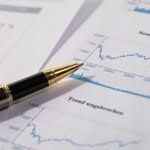 On Tuesday, Federal Reserve Chairman Ben Bernanke’s made his semiannual monetary policy testimony before the Senate Banking Committee. Washington and Wall Street wanted QE3. Bernanke demurred.
On Tuesday, Federal Reserve Chairman Ben Bernanke’s made his semiannual monetary policy testimony before the Senate Banking Committee. Washington and Wall Street wanted QE3. Bernanke demurred.
Following the testimony, Senator Chuck Schumer told Federal Reserve Chairman Ben Bernanke to “get to work.” Schumer, like most Senators, is under the illusion that Bernanke can actually do something to improve the economy. Those days are gone.
“The question in my mind is, is he [Bernanke] not stepping up with another program in any quick fashion because they’re [The Fed] starting to wonder if it’s going to have any impact? Alternatively, are they not stepping up because when they look at the data they think, ‘It’s not that bad,’?” said Jim Paulsen, chief market strategist at Wells Capital Management in Minneapolis, following Bernanke’s testimony. “Maybe it’s some of both. But does anyone need any more excess bank reserves?”
Obviously, Paulson’s last question was intended to make the point that there’s already too much credit available to banks. The problem is, there’s nowhere for the banks to put the credit to use. When banks gaze out upon the economic landscape they don’t see anything worthy of extending the credit to…especially when they can borrow money from the Fed at practically zero percent and lend it back to the government with purchases of 10-Year Treasury notes yielding 1.5 percent.
What this means is the financial system currently has no use for the Fed’s one and only product – bank credit.
Price Distortions
Banks don’t believe loaning money to businesses will turn a consistent profit. This means the Fed can no longer juice the economy with cheap money. Like repeated applications of fertilizer, or a second helping of chocolate cake, QE has reached a state of diminishing marginal returns.
Nonetheless, Schumer, like Wall Street and Washington, want Bernanke to do something more. Here at the Economic Prism we believe Bernanke has already done far too much. The federal funds rate is at effectively zero, banks are flooded with credit, and the Fed’s balance sheet is at nearly $3 trillion. Still the economy lumbers along like an old Plymouth down a dusty dirt road.
At this point, the Fed’s monetary efforts won’t do a lick for the economy. Adding another $1 trillion to the Fed’s balance sheet won’t do anything for business. Instead, all it will do is inflate asset prices.
But the S&P500’s making its way to 1,400 and oil’s back above 90 per barrel. Gold’s even scratching for 1,600 per ounce. At the moment, assets have already been over inflated with Fed gas. Their prices are totally distorted from the realities of the actual economy.
The Fed knows they must let some air out of these assets before opening the monetary valve again. If they take action now, prices – including consumer prices – could skyrocket just as the economy cools off. That would make for the worst of both negatives…a stagnating economy with rising prices.
Back in the 1970’s that was called stagflation. While Schumer may have forgotten stagflation and the misery index, Bernanke certainly hasn’t. He spent his entire career studying these things. Plus, while the economy may already be slowing down, it is also rapidly approaching the fiscal cliff with no one at the wheel…
Get Ready for a Massive Stock Market Selloff
Beginning in January, 2013, massive tax increases and haphazard government spending cuts will be triggered. From our vantage point, it appears Congress is unwilling and incapable of redirecting the economy away from the imminent fiscal cliff. They are stuck in a Congressional standoff and no one’s willing to budge.
Thus, if nothing happens before the end of the year, taxes will increase nearly $3,800 per taxpayer. That’s over $300 per month…which equals a little less than a monthly car payment or preschool tuition. The vast array of taxes to increase include the income tax, alternative minimum tax, the estate tax, payroll taxes and a new healthcare tax for Medicare. Government spending cuts include defense spending, unemployment benefits, and physician payments to Medicare.
According to estimates from Goldman Sachs, Citigroup, Merrill Lynch, and Morgan Stanley, the fiscal cliff will result in a 4 to 5 percent GDP contraction. No doubt, with GDP currently increasing at just 1.9 percent, this will push the economy into a recession. In fact, the Congressional Budget Office has crunched the numbers and believes driving off the fiscal cliff will result in recession. Yet Congress is taking a one month vacation.
Down here with the rest of us the evidence that things just ain’t right continues to pile up like cow pies on a dairy farm. Just yesterday we learned from the National Association of Realtors that sales of previously occupied homes fell 5.4 percent in June. So, too, we learned from the Labor Department that the number of Americans applying for unemployment benefits rose by 34,000 to a seasonally adjusted 386,000. On top of that the Conference Board said its index of leading economic indicators declined 0.3 percent in June.
The stock market may be a little slow…but we’re confident it will figure things out soon enough. No Fed gas. Economy rapidly approaching recession, if not already in one. Congressional stalemate.
Get ready for a massive stock market selloff. It’s coming. You can just feel it in your gut.
Sincerely,
MN Gordon
for Economic Prism
Return from Get Ready for a Massive Stock Market Selloff to Economic Prism





Pingback: Providence Is With Us